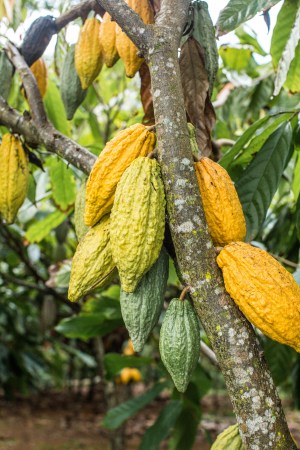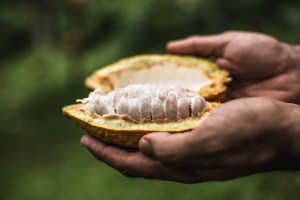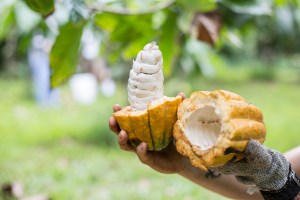Chocolate Education: Chocolate, Then & Now
The chocolate tree has a rich cultural history. As we head into the holiday season we wanted to share with you some of those stories that took chocolate from its humble jungle origins to the center stage of culinary culture. We hope you enjoy!
Cacao originated in the Amazon region of South America and we can date it’s consumption there to over 5000 years ago. To appreciate the influence of this remarkable plant, you have to remember that from ancient times cacao beans were central to both the religion and the daily life of South American and Mesoamerican cultures. The tree was central to their origin myths, and they worshipped it as a divine plant. A form of chocolate drink was used as a sacrament in religious rituals representing the blood of a divinity — not unlike the way wine is used in the catholic communion.

The Mesoamericans also used cacao beans as money. Paleo Economists have shown that each bean was worth, in today’s terms, about a dollar apiece. Spanish conquistadores ransacking Montezuma’s treasury in the 1520’s found that the emperor’s Fort Knox contained not gold or silver, but over one billion cacao beans. Kakowa, the one original word for the chocolate tree was hard for Spaniards to pronounce, so they called it Cacao. Later on when the English encountered it they called it Cocoa.

Drinking chocolate first reached the Western world in the 1500’s, and with the addition of sugar, quickly became all the rage for the few who could afford it. Chocolate houses sprang up throughout Europe, and by 1600, if you were anybody important in Madrid or Amsterdam, Paris or London, you’d go to a Chocolate House to enjoy the stimulating properties of this novel brew. Over the coming centuries, coffee and tea would also be popular, but compared to chocolate, they are both very late to the party. Chocolate’s energizing and mood-improving effects were so well known in Europe that when scientific names were given to plants in the mid-1700’s, the tree was awarded the title Theobroma — Greek for food of the gods. So, if chocolate was so venerated in European and in Mesoamerican history then, what happened?
We pick up our story of chocolate in the 1800’s when it was famed as a health tonic beverage throughout Europe and beyond. Next, the creation of milk chocolate and the modern chocolate landscape. In the late 1800’s two entrepreneur industrialists, Milton ‘Snavely’ Hershey in the US, and John Cadbury in England had huge success with a new kind of chocolate, milk chocolate. Unlike the dark milk chocolates we sell — their formulation didn’t have much chocolate in it. The addition of large amounts of milk powder and sugar meant that they needed to use less of the expensive cacao beans, which meant they were able to charge a price so low that the average person could afford it. And, because most of the flavor was coming from the milk and sugar, lower quality beans could be used, so, on the farmers side, thousands of years of careful breeding for tasty beans were disregarded in favor of trees with high yield and disease resistance. And as the industrial sugar boom of the late 1800’s ensued many began to see chocolate as just another kind of candy. In the minds of many the health benefits of chocolate were forgotten — now it was a brown melty candy. This was industrial chocolate.

Fast forward 100 years to the mid 1990’s when we began to see a resurgence of chocolate bar makers using the pre industrial small-batch techniques of old Europe, all searching the globe for the highest quality cacao beans, and seeking to discover the distinctive flavors of beans from a single origin or single estate. Collectively this became known as the bean to bar movement. Today, bean to bar chocolate makers seek to create relationships with cacao farms and are willing to pay more money for high quality beans, giving financial incentive to farmers to grow the tastiest varieties and produce a high quality crop.

This is similar story to the coffee industry. Compare Folgers and choc-ful-o-nuts to the coffee selection available today. Or to micro-brews, or to the wine industry, where the consumer is well aware of the flavor and value of high quality products.
Cacao was brought to Hawaii by Wilhelm Hillebrand in the 1870’s (for whom my great-grandfather Lydgate worked for as a young man). However, for a long time, crops like sugar and pineapple drew most of our attention here in the islands. But with the death of big sugar and pineapple there has been an emergence of chocolate growing in here in the islands. Hawaii is a cacao origin that some serious advantages: Wonderful growing conditions, an unprecedented level of infrastructure, affluent and interested agricultural advocates, and the educational and governmental institutions of the USA, a powerful combination for quality production. This has made us a growing location that everyone is paying attention to, and wants to visit! And for those of you who have tried our chocolate, I am sure you will agree we are off to a good start writing the next chapter in chocolate’s long and rich history.
Stay tuned for our next blog post!
